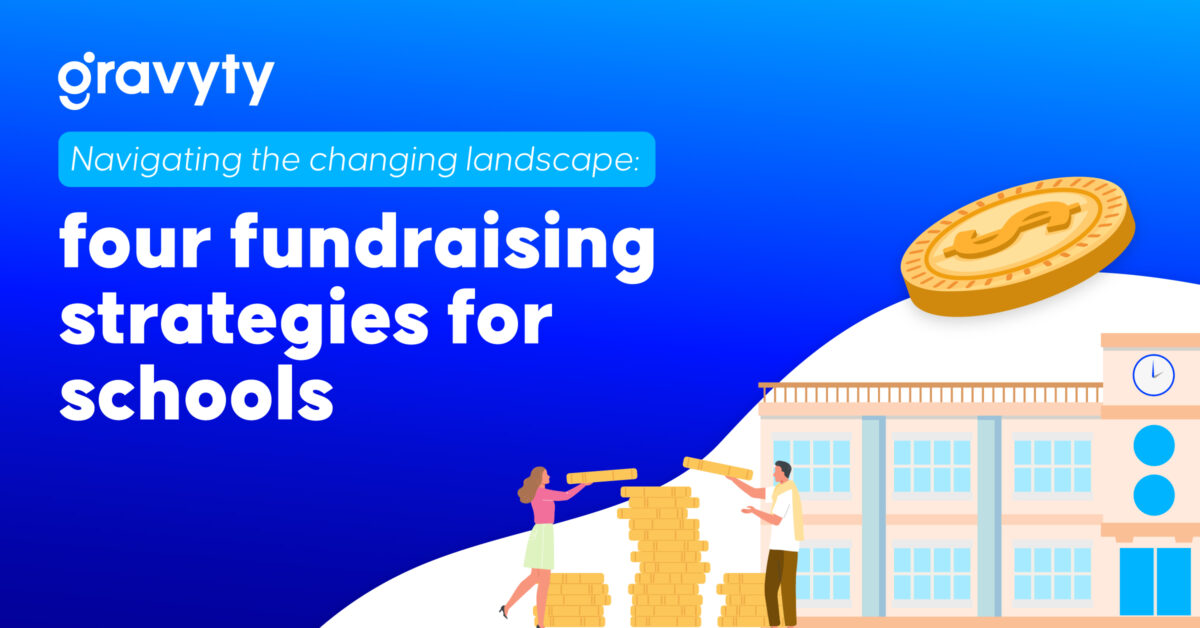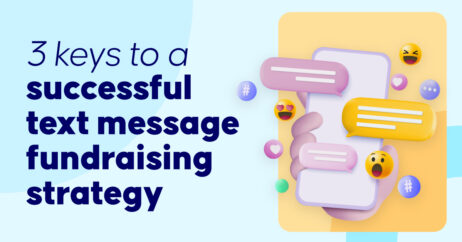Navigating a changing landscape: four fundraising strategies for schools

Fundraising in the K12 space has changed dramatically in recent years. Just as the Covid pandemic shifted most industries online, there has also been a significant shift towards virtual fundraising across all nonprofits, including schools. In addition to holding fewer in-house events and increasing the number and range of virtual and hybrid events, K12 fundraisers are increasingly exploring the use of fundraising technologies to expand their capacity to fundraise and reduce manual, repetitive and low-level administrative tasks. Winning organizations know that change is unavoidable and are always prepared to adapt as required by the situation. This article runs through four fundraising strategies for schools to help keep their operations strong in the new fundraising reality.
As the world undergoes economic challenges, there have also been significant shifts in fundraising distribution. Economic downturns can impact the capacity of individuals to donate. According to research by Giving USA’s Annual Philanthropy report 2023, individual giving decreased 6.4 percent between 2021 and 2022, while foundation giving increased 2.5 percent, and corporate giving grew 18.2 percent between 2020 and 2021 and 3.4 percent between 2021 and 2022. In challenging economic climates, everyone is more discerning regarding where to put their money, and schools not only struggle to maintain former gift levels from individual donors, but they may also have to work harder to win those corporate and foundation donations too.
Technologies growing in popularity in the K12 space include online community platforms used for volunteer and donor engagement, designated software solutions that help schools run giving days and fundraising campaigns and AI-based tools that assist fundraising staff in engaging with more donors while spending less time and effort than required previously.
1. Address staffing challenges by leveraging technology
The fundraising industry is notorious for having an extremely high employee turnover rate. A recent study of fundraising professionals found that 46% intend to leave their current employer within the next two years, while 9% of respondents to the report “What Makes Fundraisers Tick?” planned to leave the fundraising field altogether within the next two years.
In response to these high turnover rates, fundraising employers often have little choice but to hire staff with minimal prior fundraising experience, imposing additional burdens on the already challenged daily operations.
The high attrition rate of fundraising staff in the K12 nonprofit space is almost certainly related to the job’s demands. Pervasive understaffing means that the daily pile of each existing employee is that much greater. As well as maintaining warm, personal relationships with multiple donors on different donor levels, staff might also have to organize events, coordinate volunteers and perform mountains of administrative tasks each day.
Fundraising technologies can alleviate many of these burdens and allow each staff member to increase their work capacity relatively easily. Such solutions can also help inexperienced get up to speed with their roles faster and even perform at the same level as someone with much more experience.
AI-based fundraising tools like Raise from Gravyty can be particularly helpful. With full access to the data stored in the organization’s CRM, Raise understands the full picture and is primed to prompt fundraising staff when it’s time to reach out to a donor, even suggesting what kind of approach to make – be that fundraising request, general outreach, greeting, etc. The tool even drafts emails that mimic the staff member’s writing style (thanks to AI) and inserts relevant personal details from the CRM that elevate communications from the generic to the personal.
Fundraising platforms like Advance can help fundraisers pull off major events—such as Giving Days or an annual appeal—with relative ease. As well as incorporating functionality to gamify online giving and increase excitement and engagement, such platforms help manage large teams of staff and volunteers and execute an entire fundraising event efficiently from beginning to end. Let’s explore a few more fundraising strategies for schools.
2. Maximize donor engagement with effective tracking systems
The key to continuous improvement is tracking. It is only by knowing how well (or poorly) your previous outreach attempts performed that you build on this knowledge to do better and better each time. In a manual fundraising office, tracking is tedious, inefficient, and time-consuming and usually involves repeated dives into the database or certain Excel spreadsheets. The beauty of a more technological approach to fundraising is that the platforms that make the day-to-day job of the fundraiser easier also help enormously with tracking results.
Raise, for example, automatically records each touchpoint—including emails sent, calls, event attendance, and more—with donors in the database. By looking at this information in conjunction with gift information, it is easy to see which types of outreach were the most effective for different donors. Fundraisers will often be able to spot patterns that help them refine their approach for next time; for example, a certain donor may be more responsive to phone calls than emails or may only respond to sport-related tasks, as opposed to those that support other school activities. This is one of several fundraising strategies for schools to build better relationships with donors by responding more appropriately to the personal preferences of each donor.
Similarly, a community platform like Graduway allows fundraisers to easily see how engaged certain donors are and what campaigns or activities are most attractive to them. For example, an alumnus who regularly participates on boards speaking about volunteership may be open to becoming a mentor, thus further cementing their relationship with the school.
3. Respond to decreasing household giving trends
In an environment where donations from individuals are declining, K12 fundraisers must make more of an effort to ensure that the outreach actions taken and the communications sent out are hitting the mark. Using an end-to-end engagement platform such as Graduway from Gravyty, as well as an AI-based fundraising platform such as Raise from Gravyty, can help greatly to this end.
Providing an alumni engagement platform through Graduway is a great way to maintain healthy relationships with donors and would-be donors while increasing enthusiasm and engagement. By offering a convenient online space for social interaction, mentorship activity, career networking, and volunteership, community platforms can make donors more enthused about their communities and inspired to give back. It also offers a great space to inform donors about what’s happening in the school community and maintain a steady two-way stream of communication.
AI-based fundraising solutions like Raise sit on your organization’s CRM and make it easy to track every donor touchpoint, as well as dive into details about which outreach attempts they responded to, which campaigns they tend to support, and what fundraising opportunities interest them the most.
Diving into this data can help fundraisers devise approaches with a higher chance of success. Even though times are tough, many donors will be moved to make a gift if the appeal and the approach are right. Taking the time to analyze the data can make a massive difference and may even help revive a dormant donor.
4. Fundraiser bandwidth: prioritizing effective fundraising activities
Fundraising is all about relationships, and as every fundraiser knows, building meaningful relationships takes a lot of time and multiple touch points. The relationship aspects of fundraising are often first to be impacted when staff are overstretched, or there are not enough people on the job. Generally, each fundraiser manages a portfolio of donors and in a low-staff environment, the number of donors in each portfolio can be insurmountably large. When considering fundraising strategies for schools, it’s crucial to monitor this bandwidth.
This is where a fundraising tool like Raise can be especially helpful. Raise uses AI to intelligently sort through your CRM and suggest fundraising approaches suitable for donors at different stages of the relationship and at different giving levels. Instead of fundraisers having to access the database to create lists of donors to contact for different purposes, Raise does the hard work of filtering the information and simply prompts fundraisers when it’s time to make an approach. AI fundraising tools make both prospecting and stewarding donors easier and more efficient. They also reduce the number of face-to-face interactions (or personal calls) needed.
By drafting emails that use personal details from the CRM and are written the “voice” of the fundraiser, Raise makes each communication seem more personal, thus alleviating some of the burdens of having to reach out one by one. This can be especially helpful at the busiest giving times of the year when multiple donors must be thanked within a short space of time.
Are you ready for change?
Adapting to change can be hard, especially in an educational setting where resources might already be stretched. Fortunately, fundraising tools specifically designed with the needs of K12 fundraisers in mind already exist. AI-based fundraising technologies, interactive fundraising platforms and community platforms all help alleviate the pressures and make it possible to do more with less staff. Embracing change by getting up-to-speed with new fundraising strategies for schools is one of the best ways to ride the wave and remain strong in this new era of K12 fundraising.
Learn more about Graduway, Raise, and Advance from Gravyty.




